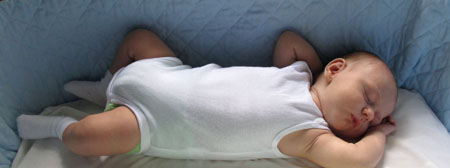Sleep, Little Baby
Parents can help their newborns sleep well, but must remember that waking up often is healthy
No statement has as much power to evoke envy on the park bench as “My baby falls asleep easily every night.”
When sleep-deprived moms and dads, who are woken up every two hours by their baby, hear such words from other parents,
they may feel they are doing something wrong. However, every child will have his or her own individual sleep needs, according to the American Academy of Pediatrics (AAP).
Until they are more than six months old, babies do not even have
regular sleep cycles. Newborns sleep about sixteen to seventeen hours per day, but they may only sleep one or two hours at a time. The AAP assures parents that it’s normal and healthy for a 6-month-old to wake up during the night. While
some babies may go back to sleep after a few minutes, parents need to be aware that their precious little one may not, and that is okay.
Still, there are some methods that parents can try to help their baby sleep well, and hopefully lead
to better sleep for mom and dad, too. The AAP suggests that parents:
Keep the environment quiet and calm. When it is time to feed or change your baby during the night, don’t stimulate her or even try to
wake her fully.
- Try putting your baby to bed when he is drowsy but awake. This may help him learn to fall asleep on his own. Holding or rocking your baby until he is in a deep sleep may affect his ability to fall back to sleep if he wakes during the night. This method won’t work for all babies, however, and some may need to be in a deep sleep before they can be put in their crib. Recognize what pattern works best for your child.Wait a few minutes before responding to fussing during the night.
- Giving your baby a little time when she first starts to cry will give her a chance to fall back to sleep on her own. If she doesn’t, go ahead and check on your baby to make sure she isn’t hungry, soiled, or not feeling well. But follow the advice of the first tip—don’t turn on the light, try to play, or do anything that might stimulate your baby.
- Make the day your baby’s time to play. Let the stimulation rise with the sun. Playing and talking with your baby during the day may lengthen the time he is awake. This will in turn help him sleep for longer periods during the night.
Even when trying these tips, parents should not feel pressure to have their baby sleep too deeply or too long before they are ready. The AAP urges parents to understand that children are considered good sleepers
if they wake up often but can fall back to sleep with some ease, as opposed to an infant who sleeps several hours without waking. Undisturbed sleep for long periods of time is not considered healthy because it doesn’t allow babies the chance
to alert their parents if they are having breathing problems. 

Back to Sleep, Tummy to Play
Good sleep for infants must always be safe sleep as well. According to the American Academy of Pediatrics (AAP), the two most important things to remember about safe sleep practice are that babies are safest when sleeping on their backs, and that
tummy time is for babies who are awake and under supervision.
That’s why the AAP hopes parents can remember this simple phrase: back to sleep, tummy to play.
To reduce the risk of suffocation, entrapment, or
sudden infant death syndrome (SIDS), the AAP asks parents to:
- Place your baby on his or her back for every sleep, even short naps.
- Use a firm sleep surface. Cribs and bassinets should meet current safety standards and not been subject to recalls. Cover the mattress with a fitted sheet, and don’t put blankets or pillows between the mattress and sheet. Never put your baby to sleep in a chair, sofa, cushion, water bed or other surfaces that are not firm.
- Keep all soft objects and loose bedding out of the crib until your baby is at least 1 year old. Pillows, quilts, sheepskins, stuffed toys and bumper pads can cause suffocation.
- Keep your crib and bassinet within arm’s reach of your bed, but do not share you bed with your baby. Infants who sleep in the same bed as their parents are at risk of suffocation and SIDS.
- Don’t use positioners and other products that claim to reduce the risk of SIDS. These products have been shown to be ineffective, unnecessary, and sometimes even harmful to your baby.
Keep a comfortable temperature in the room where your baby sleeps. Use sleep clothing that is designed to keep babies warm without covering their heads.
When it’s time to
play, give you baby some tummy time! Two or three times a day for a short period of time helps your baby develop his or her muscles. Put yourself or a toy just within reach for your baby to touch and play with. Let your baby roll over, crawl, and
scoot on his or her belly. This is not only fun, but it also gives your baby a chance to build his or her strength.
Learn more:
For more tips on safe sleep and many other parenting questions, visit www.healthychildren.org, a website from the American Academy of Pediatrics.
For more information about crib safety standards,
visit the Consumer Product Safety Commission website at www.cpsc.gov.
We also have lots of information for
new moms on our website here: www.sjchs.org/TelfairBirthPlace.